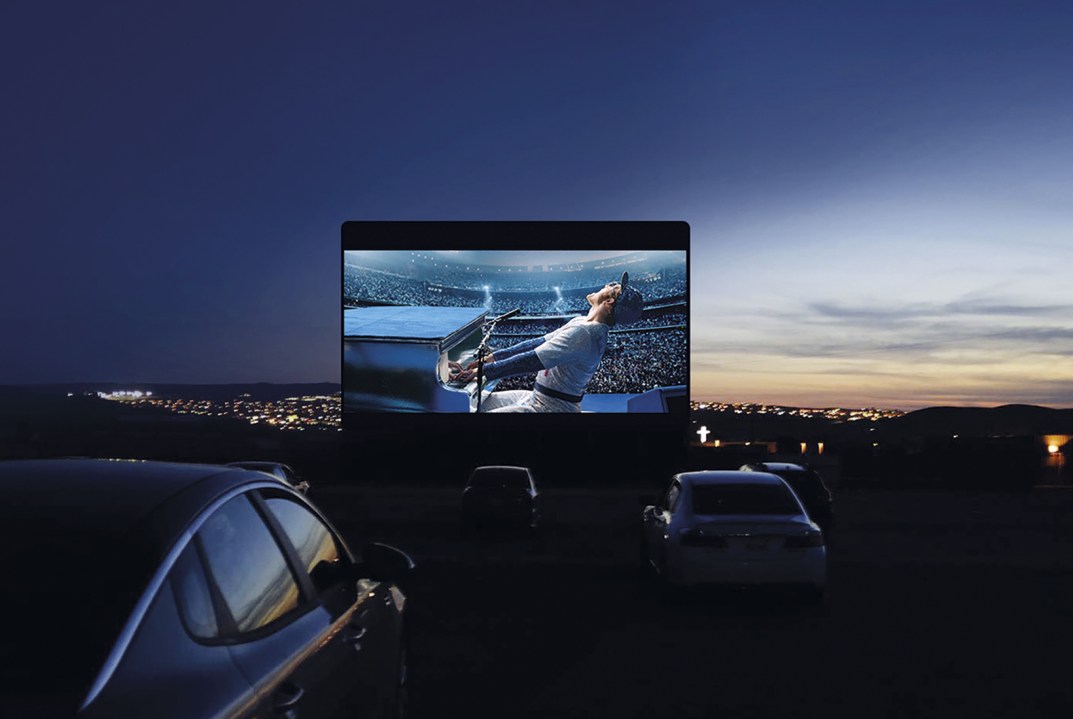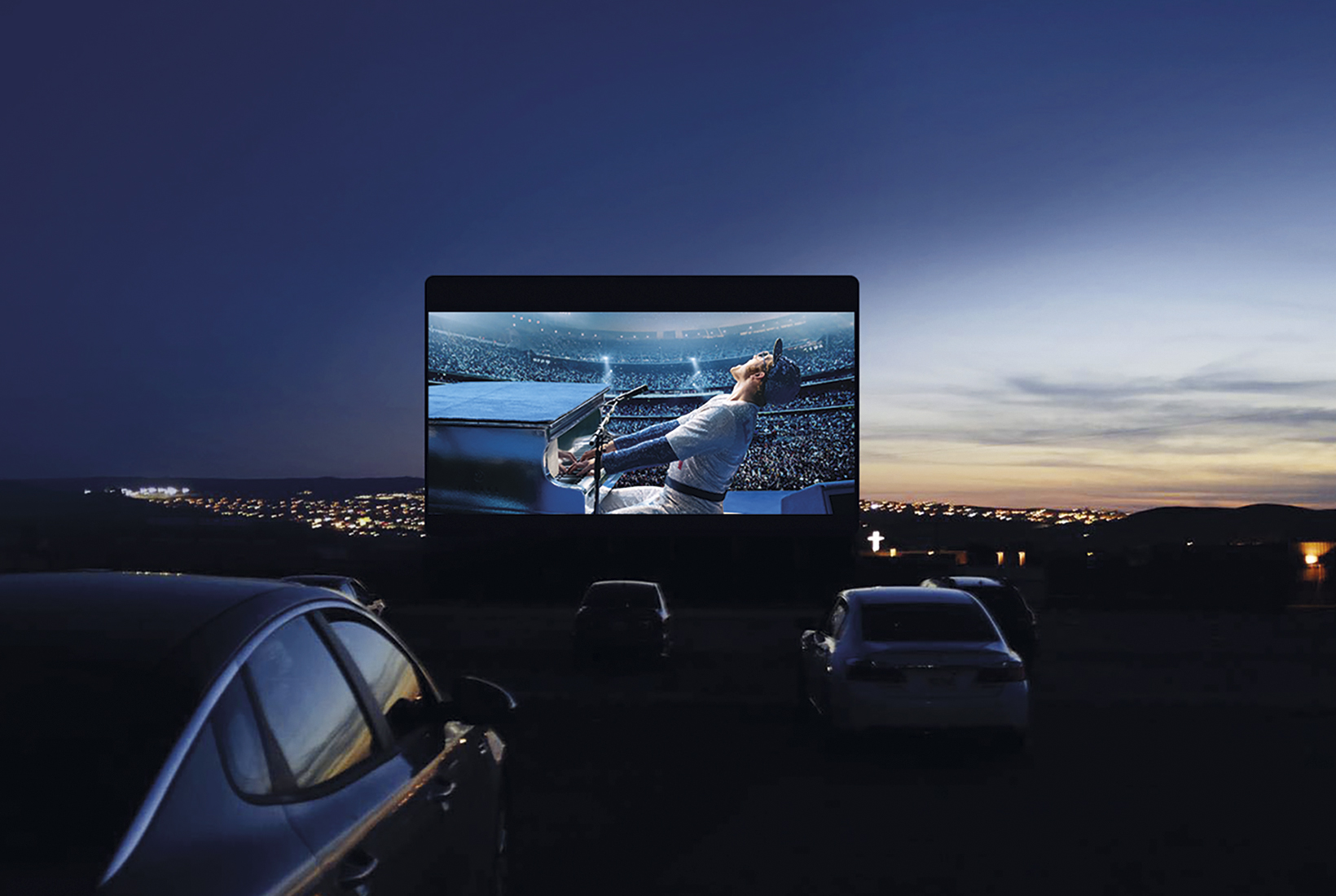Pandemic creates the oddest phenomena: here, for instance, is a British drive-in cinema. They exist for people who won’t go to a conventional cinema for fear of infection, which sounds like a film in itself. But that is the charm: attending a drive-in cinema feels like living inside a film, because every British drive-in cinema until now has failed.
It is an American invention, of course, and American cinema honours the drive-in with multiple appearances on film: in Grease (1978), where Danny jumps on Sandy as they watch a trailer for The Blob (1958); in Twister (1996), in which a tornado annihilates a drive-in cinema showing The Shining (1980); in Dead End Drive-In (1986), in which, in an apocalyptic future, drive-ins are designated concentration camps for social rejects: that is a tidy metaphor. It is no coincidence that the most popular film of the British drive-in phenomenon is Grease, which is a homage to the American car, and to the ability of American teenagers to have sex in it.
The Michelin Guide was invented by a tyre manufacturer because, in Europe, good food and scenery sold cars. In America it was bad food and static scenery: the drive-in cinema was invented by auto-parts salesman Richard Hollingshead, of Camden, New Jersey, in the early 1930s. ‘His mother was — how shall I say it? — rather large for indoor theatre seats,’ Jim Kopp of the United Drive-in Theatre Owners Association told the Smithsonian Magazine. ‘So, he stuck her in a car and put a 1928 projector on the hood of the car and tied two sheets to trees in his yard.’ Hollingshead experimented with ramps — so the viewer was not, essentially, stuck in queuing traffic — patented his invention, and showed his first film commercially on 6 June 1933. It was the British comedy Wives Beware (1932) which, according to IMDb, tells the story of ‘a man in an unsatisfying marriage [who] fakes amnesia in his sly pursuit of extramarital adventures’. The cost was 25 cents a car; at a conventional cinema in 1933 you would pay that for just one ticket. Hollingshead’s mantra was: ‘The whole family is welcome, regardless of how noisy the children are.’
It is explicitly a shared social event, like a festival, with the novelty of Julie Andrews’s giant singing head
Sound was initially a problem — it usually is when cinema innovates — but, after in-car speakers were invented in the 1940s, drive-in cinemas thrived. They solved practical problems for families seeking entertainment: they were cheap; you could smoke; you could bring your own food; the children could sleep through it. By 1958 there were 4,063 drive-in cinemas in America, largely in rural areas. They were a perfect expression of American car culture and American individualism. Their heyday was the 1950s and the 1960s. After that they ebbed as towns expanded and the drive-in sites — at least 15 acres is needed for a large drive-in cinema — became valuable to property developers. Cars became less comfortable as the oil crisis of the 1970s led to a vogue to downsize. People preferred to watch films on VHS or in multiplexes with all their tinny comforts. The sexual revolution, which arrived slightly later than the drive-in boom, meant that young people did not need to leave their homes to have sex.
Drive-in cinemas never thrived in Britain. Although there are still 335 drive-in cinemas in America today, and they cling on in Australia and Canada — they are a creature of wide lands and big skies — all permanent drive-in cinemas in the UK have failed. Karina Aveyard, associate professor of media, arts and humanities at the University of East Anglia, considers climate, topography and national character as the causes of this: Britain is wet, comparatively small and — crucially — the sun sets later here than in the Midwest of America and in Australia. We do not have the same car culture as the Americans. We enjoy sharing public spaces; or, rather, we used to.
Her interest in drive-in cinemas was prompted by her youth in Wagga Wagga, New South Wales. ‘My earliest memories of film-going were to the drive-in cinema,’ she says. ‘You tended to pay an amount per car. Two or five people? It didn’t really matter, although you couldn’t go with more people than the car was made for.’ (There are stories of children hidden in the boots of cars.) ‘You didn’t need to get a babysitter.’
The drive-in cinema was more subversive than the conventional cinema, which had pretensions. It was designed to be a glittering proletarian palace: a ‘picture palace’. The drive-in cinema was earthier, and more flexible and relaxed; there are anecdotes of children stealing through the fence and being given seats and popcorn. As Grease teaches us with The Blob, they tended to show the cheaper B-movies and the straight-to-video.
Now the drive-in has reappeared, and in the UK. Companies that operated profitable open-air cinemas before the pandemic saw the hunger — and the opportunity — and moved swiftly to bring cinema to the socially distanced. Conventional cinemas have re-opened using social-distancing measures, but customers are terrified. The BFI reports that the top 15 films made only £162,117 over the weekend of 3-5 July, which is cataclysmic. Downton Abbey grossed a mere £39; and kudos to the three who braved a pandemic to see it. In the first weekend of July last year, the top 15 films made £25,243,369.
George Wood is MD of Luna Cinema, which has operated open-air cinemas in parks and palaces in the UK for 12 years. ‘The move to drive-in is only brought about by the pandemic,’ he says. ‘It wasn’t something we were planning.’ His largest site is in the grounds of Blenheim Place, with space for 450 cars. His smallest is the south-east London Print Works, with space for 120 cars. ‘The demand,’ he says, ‘is clearly enormous.’
He thinks the drive-in cinema will survive the pandemic: ‘The experience is one that UK audiences haven’t had. I have a feeling we will end up doing drive-in every year.’ Other art forms are experimenting too. There is Car Park Theatre’s Horrible Histories: Barmy Britain and Drive & Live from the ENO, showing La Bohème.
Open Air Cinemas show films on sites across Devon and Cornwall. ‘We wanted to put something on for the community and to provide a respite for a very challenging couple of months,’ says director Adam Barnes. Very few films have been released since mid-March; instead they screen family-style hits with dancing and dinosaurs, the classic fare of the nostalgic or depressed: Grease; Dirty Dancing; Jurassic Park; Mamma Mia!.
I drive to Plymouth to watch Mary Poppins (1964) by the car park of Plymouth Argyle Football Club. It isn’t pretty but it is interesting. Perhaps it is only the novelty, but I am charmed: by the technology — you order popcorn by app — the pre-film music, which is ‘Que Sera, Sera’ and ‘Rock Around the Clock’ — and by the children sitting in front of their cars wearing giant headphones. (Inside a car, you listen through the radio; or they bring a radio to you.) Some of the children stand up and dance with Bert and the chimney sweeps. It doesn’t have the intensity of a conventional cinema but that is likeable: it is explicitly a shared social event, like a festival or BBQ, with the novelty of Julie Andrews’s giant singing head. I drift in and out. At the end I see a queue of cars waiting for a sell-out performance of Ferris Bueller’s Day Off (1986).
Drive-in is a response to pandemic, then; and a nostalgia for something we never had in Britain, but imagined we had, due to the enchantment of cinema. I suspect it will not endure as mainstream entertainment. Rather, it will flower and wither in this peculiar summertime; and that is cinematic.
Luna Cinema, Open Air Cinemas, Cinestock and At The Drive-In are a few of the ventures offering drive-in cinema at selected locations around the country. Visit life.spectator.co.uk/drivein to find a cinema near you.








Comments